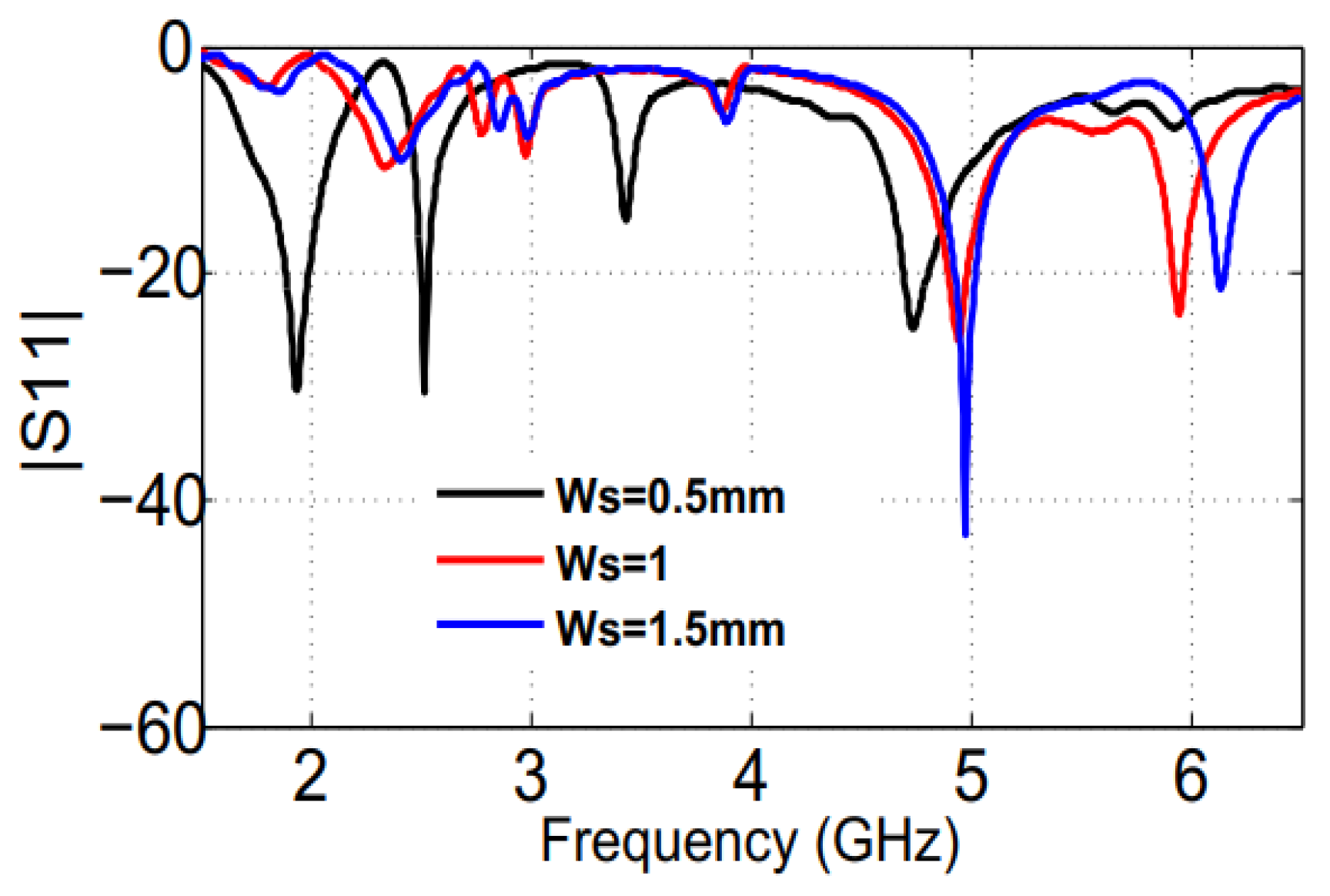Hilbert Fractal PIFA Antenna for DCS, PCS, UMTS and WiMAX Wireless Applications †
Abstract
:1. Introduction
2. Design of the Proposed Antenna
2.1. Initial PIFA antenna Design
2.2. Quad-Band PIFA Antenna
3. Parametric Studies
4. Discussion of Results
5. Conclusions
Author Contributions
Funding
Institutional Review Board Statement
Informed Consent Statement
Data Availability Statement
Conflicts of Interest
References
- Yadav, S.; Jain, P.; Choudhary, R. A novel approach of triangular-circular fractal antenna. In Proceedings of the 2014 International Conference on Advances in Computing, Communications and Informatics (ICACCI), Delhi, India, 24–27 September 2014; pp. 708–711. [Google Scholar]
- Hang, W.; Kwai-Man, L.; Chi Hou, C.; Quan, X.; Kwok Kan, S.; HauWah, L. Small antennas in Wireless Communications. Proc. IEEE J. 2012, 100, 2109–2121. [Google Scholar] [CrossRef]
- Kang, D.-G.; Sung, Y. Coupled-fed planar printed shorted monopole antenna for LTE/WWAN mobile handset applications. IET Microwaves, Antennas Propag. 2012, 6, 1007–1016. [Google Scholar] [CrossRef]
- Guo, Y.-X.; Tan, H.S. New compact six-band internal antenna. IEEE Antennas Wirel. Propag. Lett. 2004, 3, 295–297. [Google Scholar] [CrossRef]
- Manteghi, M.; Rahmat-Samii, Y. A novel miniaturized triband PIFA for MIMO applications. Microw. Opt. Technol. Lett. 2007, 49, 724–731. [Google Scholar] [CrossRef]
- Naji, D.K.; Abdul-kareem, A. A dual-band U-slot PIFA antenna with ground slit for RFID applications. J. Emerg. Trends Comput. Inf. Sci. 2013, 4, 213–220. [Google Scholar]
- Keerthika, M.A.; Balachandar, P.; Jaisree, S.; Silamboli, J. Design of Dual Tshaped PIFA antenna for multiband Wireless Applications. Int. J. Eng. Sci. Res. Technol. 2015, 4, 3. [Google Scholar]
- Redzwan FN, M.; Ali, M.T.; Tan, M.M.; Miswadi, N.F. Dual-band Planar Inverted F Antenna with parasitic element for LTE and WiMAX mobile communication. In Proceedings of the 2014 International Symposium on Technology Management and Emerging Technologies, Bandung, Indonesia, 27–29 May 2014; pp. 62–67. [Google Scholar]
- Sharma, N.; Singh, G.P.; Sharma, V. Miniaturization of fractal antenna using novel Giuseppe peano geometry for wireless applications. In Proceedings of the 2016 IEEE 1st International Conference on Power Electronics, Intelligent Control and Energy Systems (ICPEICES), Delhi, India, 4–6 July 2016; pp. 1–4. [Google Scholar]
- Costanzo, S.; Qureshi, A.M. Miniaturized Planar Inverted-F Antenna Using Minkowski Pre-Fractal Structure. In Proceedings of the 2020 14th European Conference on Antennas and Propagation (EuCAP), Copenhagen, Denmark, 15–20 March 2020; pp. 1–4. [Google Scholar]
- Tarbouch, M.; El Amri, A.; Terchoune, H.; Barrou, O. Compact PIFA Antenna with H-Tree Fractal for Mobile Handset Applications. In Proceedings of the 2nd International Conference on Computing and Wireless Communication Systems (ICCWCS’17), Larache, Morocco, 14–16 November 2017; pp. 1–6. [Google Scholar]
- Sabban, A. Wearable Compact Fractal Antennas for 5G and Medical Systems. In Wearable Systems and Antennas Technologies for 5G, IOT and Medical Systems; CRC Press: Boca Raton, FL, USA, 2020; pp. 349–380. [Google Scholar]










Publisher’s Note: MDPI stays neutral with regard to jurisdictional claims in published maps and institutional affiliations. |
© 2022 by the authors. Licensee MDPI, Basel, Switzerland. This article is an open access article distributed under the terms and conditions of the Creative Commons Attribution (CC BY) license (https://creativecommons.org/licenses/by/4.0/).
Share and Cite
Zemam, Y.; Boukli Hacene, N.; Belhadef, Y. Hilbert Fractal PIFA Antenna for DCS, PCS, UMTS and WiMAX Wireless Applications. Eng. Proc. 2022, 14, 2. https://doi.org/10.3390/engproc2022014002
Zemam Y, Boukli Hacene N, Belhadef Y. Hilbert Fractal PIFA Antenna for DCS, PCS, UMTS and WiMAX Wireless Applications. Engineering Proceedings. 2022; 14(1):2. https://doi.org/10.3390/engproc2022014002
Chicago/Turabian StyleZemam, Youssouf, Noureddine Boukli Hacene, and Yamina Belhadef. 2022. "Hilbert Fractal PIFA Antenna for DCS, PCS, UMTS and WiMAX Wireless Applications" Engineering Proceedings 14, no. 1: 2. https://doi.org/10.3390/engproc2022014002
APA StyleZemam, Y., Boukli Hacene, N., & Belhadef, Y. (2022). Hilbert Fractal PIFA Antenna for DCS, PCS, UMTS and WiMAX Wireless Applications. Engineering Proceedings, 14(1), 2. https://doi.org/10.3390/engproc2022014002





